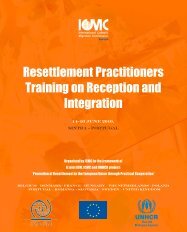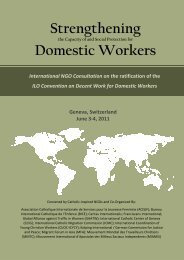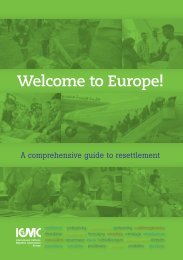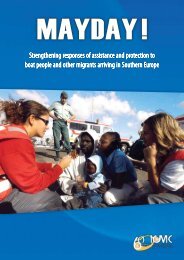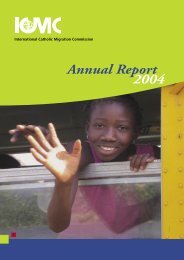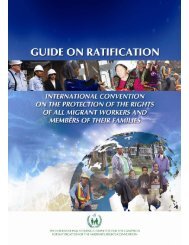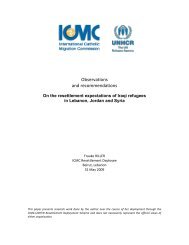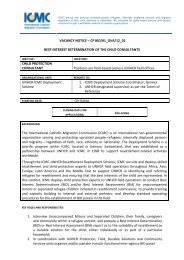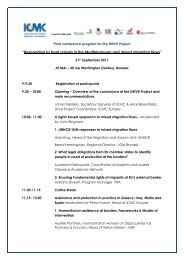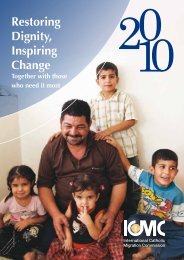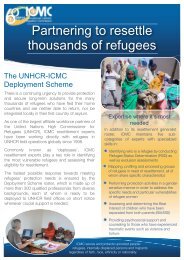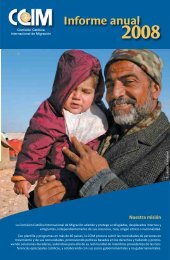Resettlement and Integration What is Resettlement? Global ... - ICMC
Resettlement and Integration What is Resettlement? Global ... - ICMC
Resettlement and Integration What is Resettlement? Global ... - ICMC
You also want an ePaper? Increase the reach of your titles
YUMPU automatically turns print PDFs into web optimized ePapers that Google loves.
<strong>Resettlement</strong> <strong>and</strong> <strong>Integration</strong><br />
<strong>What</strong> <strong>is</strong> <strong>Resettlement</strong>?<br />
<strong>Global</strong> <strong>Resettlement</strong> Needs<br />
Vulnerable Groups<br />
Emilie Wiinblad Mathez<br />
Sintra/ Portugal<br />
14 June 2010<br />
All photos are cutesy of UNHCR
Key messages<br />
<strong>Resettlement</strong> <strong>is</strong> a protection tool<br />
<strong>Resettlement</strong> <strong>is</strong> a durable solution<br />
<strong>Resettlement</strong> <strong>is</strong> a way of sharing responsibility<br />
The <strong>Global</strong> Needs for <strong>Resettlement</strong> are larger than the<br />
capacity of <strong>Resettlement</strong> countries<br />
Alike cases must be treated alike<br />
Reception <strong>and</strong> <strong>Integration</strong> <strong>is</strong> part of successful resettlement<br />
We can make deductions from the individual to the group, but<br />
not from the group to the individual<br />
UNHCR/ <strong>Resettlement</strong> Sintra,<br />
Portugal June 2010
Why <strong>Resettlement</strong>?<br />
Some refugees cannot go home<br />
Some may be living in perilous<br />
situations<br />
Some may have specific needs<br />
UNHCR helps resettle refugees in a<br />
third country<br />
There are 10.5 million refugees of<br />
concern to UNHCR worldwide<br />
Only about 1 percent are referred<br />
by the agency for resettlement.<br />
Expression of international<br />
solidarity / responsibility sharing<br />
mechan<strong>is</strong>m<br />
UNHCR/ <strong>Resettlement</strong> Sintra,<br />
Portugal June 2010<br />
Al Tanf © UNHCR/B. Diab
Perilous situation<br />
Camp & Urban<br />
Food: Kilocalories, malnutrition,<br />
variety, reg<strong>is</strong>tration, etc.<br />
Water: liters per day, cleaning<br />
Shelter: Fire, closeness, etc.<br />
Sanitation: Latrines, safety, etc.<br />
Safety: Refoulement, killings,<br />
recruitment, crime, etc.<br />
Education: Availability, material,<br />
curriculum, other duties, etc.<br />
Health: Infant motility, malaria,<br />
waterborne d<strong>is</strong>ease, chronic,<br />
serious, etc.<br />
UNHCR/ <strong>Resettlement</strong> Sintra,<br />
Portugal June 2010<br />
Al Tanf. © UNHCR/B. Auger
Special needs<br />
SGBV: Domestic violence,<br />
rape, child abuse, etc.<br />
Children: Forced marriages,<br />
recruitment, etc.<br />
Elderly: Support structures, etc.<br />
D<strong>is</strong>abled: Support structures,<br />
etc.<br />
UNHCR/ <strong>Resettlement</strong> Sintra,<br />
Portugal June 2010<br />
Dosseye camp/Chad © Zalmai
<strong>Resettlement</strong> Criteria<br />
Many Refugees live in Perilous situations<br />
in Camps or Urban environments.<br />
Not all are resettled.<br />
Some have special needs<br />
UNHCR’s <strong>Resettlement</strong> Criteria are:<br />
Legal <strong>and</strong> Physical Protection Needs<br />
Survivors of Violence <strong>and</strong> Torture<br />
Medical Needs<br />
Women-at-R<strong>is</strong>k<br />
Family Reunification<br />
Children <strong>and</strong> Adolescents<br />
Older Refugees<br />
Refugees without Local <strong>Integration</strong><br />
Prospects<br />
UNHCR/ <strong>Resettlement</strong> Sintra,<br />
Portugal June 2010<br />
Lukole camp Tanzania © E. Wiinblad
There can be no meaningful<br />
protection without the prospect<br />
of a durable solution<br />
voluntary repatriation,<br />
local integration <strong>and</strong><br />
resettlement<br />
Together forms a<br />
comprehensive approach to<br />
durable solutions<br />
Can require more flexible<br />
resettlement criteria.<br />
Particularly relevant in<br />
protracted refugee situations<br />
where protection may be<br />
available but a durable solution<br />
<strong>is</strong> not<br />
Durable Solution<br />
UNHCR/ <strong>Resettlement</strong> Sintra,<br />
Portugal June 2010<br />
Iridimi camp/Chad © Zalmai
Responsibility Sharing<br />
In essence similar to resettlement as a<br />
durable solution.<br />
Where a State provide a durable solution<br />
through resettlement, it <strong>is</strong> also<br />
sharing the responsibilities <strong>Global</strong>ly.<br />
When a State agrees to “burden share”<br />
through resettlement, it <strong>is</strong> expected to<br />
provide a durable solution.<br />
When you work with resettled refugees<br />
you share the <strong>Global</strong> responsibility to<br />
provide protection.<br />
UNHCR/ <strong>Resettlement</strong> Sintra,<br />
Portugal June 2010<br />
Syria © UNHCR/B/Heger
Strategic use of <strong>Resettlement</strong><br />
“The planned use of<br />
resettlement in a manner<br />
that maximizes the<br />
benefits, directly or<br />
indirectly, other than those<br />
received by the refugee<br />
being resettled. Those<br />
benefits may accrue to<br />
other refugees, the hosting<br />
state, other states or the<br />
international protection<br />
regime in general.”<br />
UNHCR/ <strong>Resettlement</strong> Sintra,<br />
Portugal June 2010<br />
Lukole camp Tanzania © E. Wiinblad
<strong>Global</strong> Needs - Figures<br />
805,535 identified as in need by offices<br />
around the world.<br />
2011 - 172,307 persons<br />
58,780 cases in 2011<br />
Main asylum countries 2011:<br />
Chad – 9,500, Kenya- 20,500,<br />
Malaysia – 15,000, Nepal – 18,500,<br />
Thail<strong>and</strong> – 12,300, Turkey –<br />
17,000, Syria – 23,500<br />
Main countries of origin 2011:<br />
Afghan<strong>is</strong>tan – 274,383, Somalia –<br />
150,355, Myanmar – 101,150, Iraq<br />
– 68,366, Sudan – 61,996,<br />
UNHCR/ <strong>Resettlement</strong> Sintra,<br />
Portugal June 2010<br />
Somali camp in Kenya © UNHCR/E.<br />
Hockstein
<strong>Global</strong> Needs 2011<br />
UNHCR Needs <strong>and</strong> Capacity 2007 - 2011<br />
1000000<br />
500000<br />
0<br />
2007 2008 2009 2010 2011<br />
Total RST Needs 561,127 747,468 805,535<br />
RST Needs for Year 53,129 203,527 203,259 172,307<br />
UNHCR Capacity* 37,197 103,598 126,996 41,891 74,685<br />
UNHCR/ <strong>Resettlement</strong> Sintra,<br />
Portugal June 2010
<strong>Global</strong> Needs 2011<br />
UNHCR Total <strong>Resettlement</strong> Needs by Region, 2009 - 2011<br />
500,000<br />
400,000<br />
300,000<br />
200,000<br />
100,000<br />
0<br />
2009 2010 2011<br />
Africa Americas Asia Europe MENA<br />
UNHCR/ <strong>Resettlement</strong> Sintra,<br />
Portugal June 2010
Response Capacity 2009<br />
UNHCR Subm<strong>is</strong>sions: 128,558<br />
6% increase from 121,214 refugees in 2008.<br />
Departures: 84,657 to 24 countries of resettlement.<br />
29% increase from 65,859 refugees in 2008.<br />
Origin: Refugees from Iraq compr<strong>is</strong>ed the largest<br />
number of refugees submitted for resettlement<br />
(36,067), followed by refugees from Myanmar<br />
(30,542) <strong>and</strong> Bhutan (22,114).<br />
In total the three nationalities made up 70 per cent of all<br />
subm<strong>is</strong>sions.<br />
<strong>Resettlement</strong>: The top three countries of resettlement<br />
were: the United States of America (62,011),<br />
Australia (6,720) <strong>and</strong> Canada (6,582).<br />
Nepal was the country of asylum from which the most<br />
number of refugees were submitted (22,139),<br />
followed by Thail<strong>and</strong> (19,879) <strong>and</strong> Syria (18,888).<br />
Asylum: Nepal was the country from which the most<br />
refugees departed (17,442), followed by Thail<strong>and</strong><br />
(16,835), <strong>and</strong> Syria (10,383).<br />
UNHCR/ <strong>Resettlement</strong> Sintra,<br />
Portugal June 2010<br />
Somali camp in Kenya © UNHCR/E.<br />
Hockstein
<strong>Resettlement</strong> Identification<br />
Reg<strong>is</strong>tration of the population<br />
Knowing the profile of the<br />
population<br />
Identifying r<strong>is</strong>ks <strong>and</strong> needs<br />
Using a protection <strong>and</strong> resettlement<br />
framework<br />
How?<br />
Community services<br />
Protection services<br />
Working with partners<br />
Referral – self referral<br />
Establ<strong>is</strong>hing the facts - interviewing<br />
UNHCR/ <strong>Resettlement</strong> Sintra,<br />
Portugal June 2010<br />
Somali camp in Kenya © UNHCR?E. Hockstein
<strong>Resettlement</strong> Identification<br />
Alike<br />
Cases<br />
must be<br />
treated<br />
Alike!<br />
Needs<br />
Based<br />
UNHCR/ <strong>Resettlement</strong> Sintra,<br />
Portugal June 2010<br />
Sheikh Shehzad camp © UNHCR/A. Fazzina
<strong>Resettlement</strong> Step by Step<br />
<br />
<br />
<br />
<br />
<br />
<br />
<br />
<br />
Referral<br />
Assessment<br />
Family composition<br />
Verification<br />
BID<br />
RRF<br />
Submit RRF to <strong>Resettlement</strong> Hub<br />
(i.a. Bangkok, Beirut, Nairobi)<br />
Prioritization of case (Emergency)<br />
Submitting case to potential<br />
resettlement country<br />
Country selection<br />
Dossier<br />
M<strong>is</strong>sion<br />
Pre-departure arrangement<br />
Security<br />
Travel<br />
Medical<br />
Cultural Orientation<br />
UNHCR/ <strong>Resettlement</strong> Sintra,<br />
Portugal June 2010<br />
Farchana camp/ Chad © Zamai
Vulnerable Persons<br />
Not all persons identified by<br />
UNHCR as in need of<br />
<strong>Resettlement</strong> are Vulnerable<br />
Those likely to be vulnerable are in<br />
the following categories:<br />
Survivors of Violence <strong>and</strong><br />
Torture<br />
Medical Needs<br />
Women-at-R<strong>is</strong>k<br />
Children <strong>and</strong> Adolescents<br />
Older Refugees<br />
UNHCR/ <strong>Resettlement</strong> Sintra,<br />
Portugal June 2010<br />
Farchana camp/ Chad © Zamai
Survivors of Violence <strong>and</strong> Torture<br />
WHO/UNHCR Mental Health of<br />
Refugees.<br />
Coordinated medical care,<br />
counseling <strong>and</strong> other types of<br />
special ass<strong>is</strong>tance,<br />
Family support considerations<br />
Violence <strong>and</strong> torture may be<br />
experienced differently by women<br />
<strong>and</strong> men<br />
Report of a qualified physician<br />
essential – others if possible<br />
Adequate services must be<br />
available in resettlement country<br />
RRF must reflect if individual <strong>is</strong> a<br />
survivor of violence <strong>and</strong> torture<br />
UNHCR/ <strong>Resettlement</strong> Sintra,<br />
Portugal June 2010<br />
Northern Kivu © Chr<strong>is</strong>tian Als
Medical Needs<br />
Qualified medical personnel <strong>is</strong> Consulted<br />
4 requirements<br />
<br />
<br />
<br />
<br />
Life-threatening; r<strong>is</strong>k of irreversible loss<br />
of functions; presents a significant<br />
obstacle to leading a normal life;<br />
Treatment <strong>is</strong> not available in the country<br />
of asylum; medical evacuation not<br />
enough; country of asylum situation<br />
prevents the individual from functioning<br />
at a sat<strong>is</strong>factory level (d<strong>is</strong>abled).<br />
There <strong>is</strong> a favorable prognos<strong>is</strong>; health<br />
after treatment/relocation; situation in<br />
the country of asylum <strong>is</strong> the reason -<br />
significantly worsens, the health<br />
condition;<br />
It <strong>is</strong> the expressed w<strong>is</strong>h of the individual<br />
Priority <strong>is</strong> given to those where the medical<br />
need <strong>is</strong> linked to refugee claim.<br />
UNHCR/ <strong>Resettlement</strong> Sintra,<br />
Portugal June 2010<br />
Northern Kivu © Chr<strong>is</strong>tian Als
Women at R<strong>is</strong>k<br />
May face unique or gender-related forms of<br />
persecution or violence, as a result of their sex.<br />
Considerations:<br />
<br />
<br />
<br />
<br />
Precarious security or physical protection<br />
threats as a result of her sex.<br />
Specific needs ar<strong>is</strong>ing from past persecution<br />
<strong>and</strong>/or traumatization.<br />
Circumstances of severe hardship resulting in<br />
exposure to exploitation <strong>and</strong> abuse, rendering<br />
asylum untenable.<br />
Change in the social norms etc resulting in lack<br />
of traditional protection <strong>and</strong> support<br />
Consideration should be given to resettlement when<br />
th<strong>is</strong> places the refugee woman or girl at such<br />
r<strong>is</strong>k that it renders asylum untenable.<br />
UNHCR/ <strong>Resettlement</strong> Sintra,<br />
Portugal June 2010<br />
Northern Kivu © Chr<strong>is</strong>tian Als
Children <strong>and</strong> Adolescents<br />
Below the age of 18 years<br />
Different approach guided by the CRC<br />
<strong>and</strong> the Best Interest of the Child<br />
Determination (BID)<br />
Separated <strong>and</strong> UAM are priority<br />
BID:<br />
Is a process<br />
Includes the view of the child<br />
Full assessment of needs <strong>and</strong><br />
options<br />
Based on Children’s rights<br />
Four basic elements<br />
Principles about the developmental<br />
needs of children <strong>and</strong> adolescents<br />
Set of attitudes<br />
Procedures<br />
Institutional structures<br />
UNHCR/ <strong>Resettlement</strong> Sintra,<br />
Portugal June 2010<br />
Farchana camp/ Chad © Zamai
Older Refugees<br />
There <strong>is</strong> no fixed age to define an<br />
older refugee as elderly<br />
Exceptionally used<br />
Family tracing <strong>and</strong> placement<br />
- first option<br />
Placement in other family –<br />
using community structures –<br />
other option<br />
Place with family abroad –<br />
when possible<br />
Consultation before<br />
considering solution<br />
UNHCR/ <strong>Resettlement</strong> Sintra,<br />
Portugal June 2010<br />
Serbia © UNHCR/M. Jankovic
For d<strong>is</strong>cussion during th<strong>is</strong> seminar<br />
Refugee <strong>Resettlement</strong>: An International<br />
H<strong>and</strong>book to Guide Reception <strong>and</strong><br />
<strong>Integration</strong><br />
Planning for all<br />
Taking account of Gender<br />
Investing in the future: Refugee<br />
Children <strong>and</strong> Young People<br />
Engaging Refugee Elders<br />
Hypothes<strong>is</strong>: We can make deductions<br />
from the individual to the group,<br />
but not from the group to the<br />
individual<br />
Vulnerable Persons <strong>and</strong><br />
<strong>Integration</strong><br />
UNHCR/ <strong>Resettlement</strong> Sintra,<br />
Portugal June 2010<br />
Syria © UNHCR/B/Heger
Coming Soon<br />
to a<br />
Municipality<br />
near you!<br />
Thanks<br />
UNHCR/ <strong>Resettlement</strong> Sintra,<br />
Portugal June 2010<br />
Lukole camp Tanzania © E. Wiinblad



